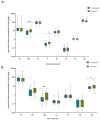Genetic Damage and Multi-Elemental Exposure in Populations in Proximity to Artisanal and Small-Scale Gold (ASGM) Mining Areas in North Colombia
- PMID: 40137529
- PMCID: PMC11946375
- DOI: 10.3390/toxics13030202
Genetic Damage and Multi-Elemental Exposure in Populations in Proximity to Artisanal and Small-Scale Gold (ASGM) Mining Areas in North Colombia
Abstract
This study evaluates DNA damage and multi-element exposure in populations from La Mojana, a region of North Colombia heavily impacted by artisanal and small-scale gold mining (ASGM). DNA damage markers from the cytokinesis-block micronucleus cytome (CBMN-Cyt) assay, including micronucleated binucleated cells (MNBN), nuclear buds (NBUDs) and nucleoplasmic bridges (NPB), were assessed in 71 exposed individuals and 37 unexposed participants. Exposed individuals had significantly higher MNBN frequencies (PR = 1.26, 95% CI: 1.02-1.57, p = 0.039). Principal Component Analysis (PCA) identified the "Soil-Derived Mining-Associated Elements" (PC1), including V, Fe, Al, Co, Ba, Se and Mn, as being strongly associated with high MNBN frequencies in the exposed population (PR = 10.45, 95% CI: 9.75-12.18, p < 0.001). GAMLSS modeling revealed non-linear effects of PC1, with greater increases in MNBN at higher concentrations, especially in exposed individuals. These results highlight the dual role of essential and toxic elements, with low concentrations being potentially protective but higher concentrations increasing genotoxicity. Women consistently exhibited higher MNBN frequencies than men, suggesting sex-specific susceptibilities. This study highlights the compounded risks of chronic metal exposure in mining-impacted regions and underscores the urgent need for targeted interventions to mitigate genotoxic risks in vulnerable populations.
Keywords: GAMLSS; La Mojana; artisanal and small-scale gold mining (ASGM); cytokinesis-block micronucleus cytome assay (CBMN-Cyt); gold mining; multi-elemental exposure.
Conflict of interest statement
The authors declare no conflicts of interest.
Figures





Similar articles
-
Influence of genetic polymorphisms of Hg metabolism and DNA repair on the frequencies of micronuclei, nucleoplasmic bridges, and nuclear buds in communities living in gold mining areas.Mutat Res Genet Toxicol Environ Mutagen. 2024 Jul;897:503790. doi: 10.1016/j.mrgentox.2024.503790. Epub 2024 Jun 13. Mutat Res Genet Toxicol Environ Mutagen. 2024. PMID: 39054006
-
Dietary exposure to mercury and its relation to cytogenetic instability in populations from "La Mojana" region, northern Colombia.Chemosphere. 2021 Feb;265:129066. doi: 10.1016/j.chemosphere.2020.129066. Epub 2020 Nov 21. Chemosphere. 2021. PMID: 33293049
-
Cytogenetic instability in populations with residential proximity to open-pit coal mine in Northern Colombia in relation to PM10 and PM2.5 levels.Ecotoxicol Environ Saf. 2018 Feb;148:453-466. doi: 10.1016/j.ecoenv.2017.10.044. Epub 2017 Nov 6. Ecotoxicol Environ Saf. 2018. PMID: 29102906
-
Artisanal and small-scale gold mining and biodiversity: a global literature review.Ecotoxicology. 2024 Jul;33(4-5):484-504. doi: 10.1007/s10646-024-02748-w. Epub 2024 May 7. Ecotoxicology. 2024. PMID: 38713425 Review.
-
Mercury exposure and health impacts among individuals in the artisanal and small-scale gold mining community: a comprehensive review.Environ Health Perspect. 2014 Jul;122(7):667-72. doi: 10.1289/ehp.1307864. Epub 2014 Mar 28. Environ Health Perspect. 2014. PMID: 24682486 Free PMC article. Review.
References
-
- Pinilla A.R.R., Espana V.A.A. Derelict Mines. CRC Press; Boca Raton, FL, USA: 2025. Mining in Colombia: An Opportunity for Better Management of Environmental Impacts; pp. 90–106.
-
- Betancur-Corredor B., Loaiza-Usuga J.C., Denich M., Borgemeister C. Gold mining as a potential driver of development in Colombia: Challenges and opportunities. J. Clean. Prod. 2018;199:538–553. doi: 10.1016/j.jclepro.2018.07.142. - DOI
-
- Cano-Londoño N.A., Capaz R.S., Hasenstab C., Velásquez H.I., McIntyre N., Corder G.D., Posada J.A. Life cycle impacts assessment of two gold extraction systems in Colombia: Open-pit and alluvial mining. Int. J. Life Cycle Assess. 2023;28:380–397. doi: 10.1007/s11367-023-02141-5. - DOI
-
- Santos R.J. Blessing and curse. The gold boom and local development in Colombia. World Dev. 2018;106:337–355. doi: 10.1016/j.worlddev.2018.02.016. - DOI
-
- Ngom N.M., Baratoux D., Bolay M., Dessertine A., Abass Saley A., Baratoux L., Mbaye M., Faye G., Yao A.K., Kouamé K.J. Artisanal Exploitation of Mineral Resources: Remote Sensing Observations of Environmental Consequences, Social and Ethical Aspects. Surv. Geophys. 2023;44:225–247. doi: 10.1007/s10712-022-09740-1. - DOI
Grants and funding
LinkOut - more resources
Full Text Sources
Research Materials
Miscellaneous

